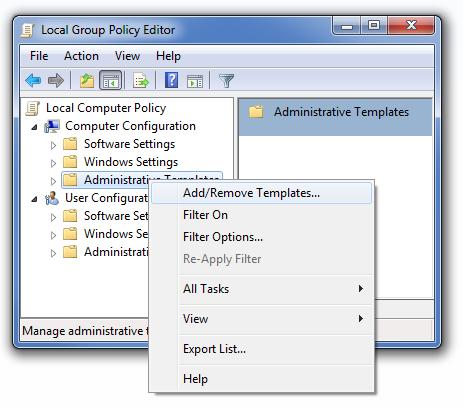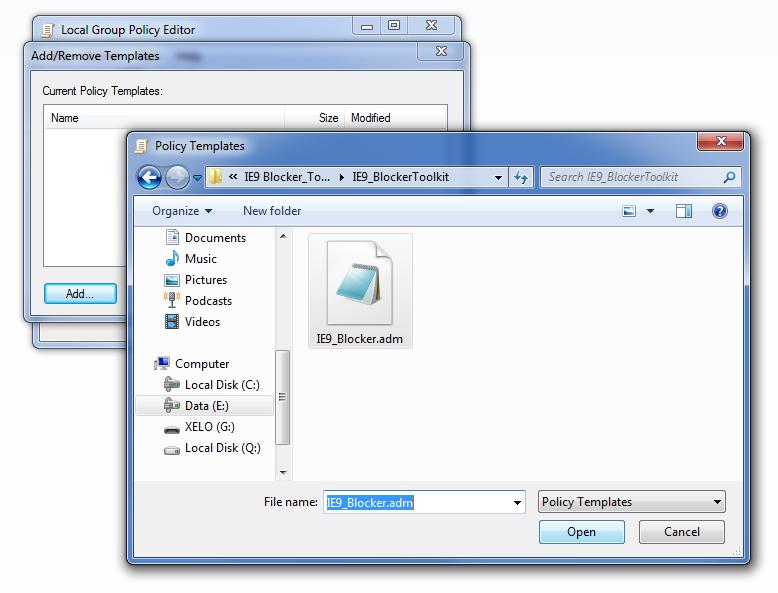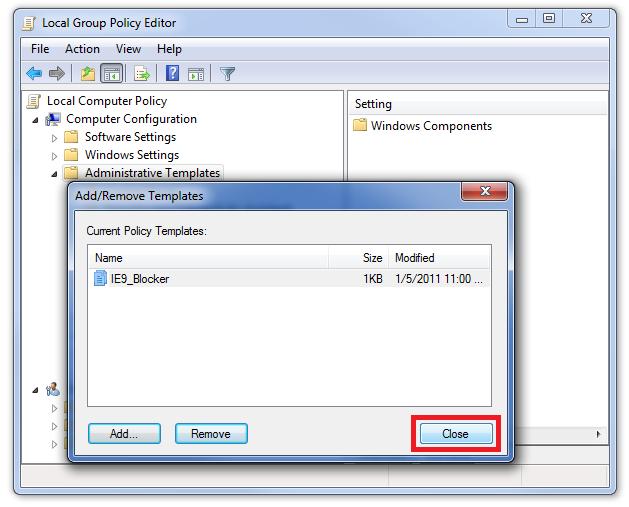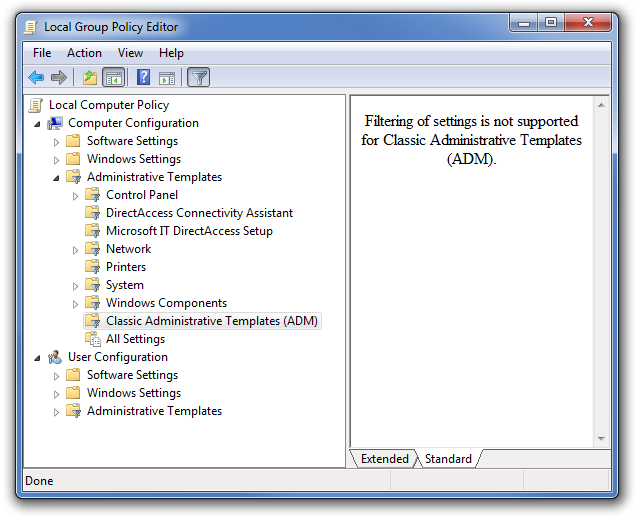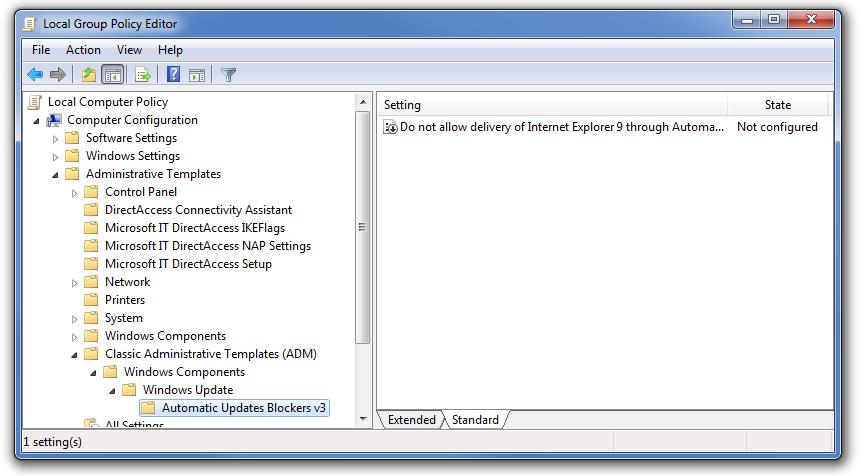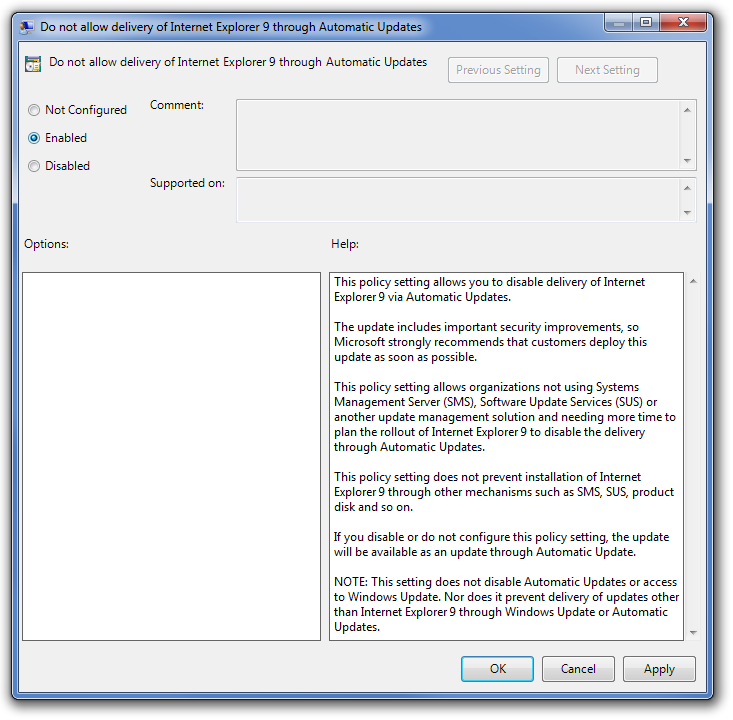How to configure the IE9 Blocker Toolkit Policy
Hi everyone!
Axel Rivera with another blog that provides a step by step instructions on how to load the IE9 Blocker Administrative Template provided with the IE 9 Toolkit that enables IE Administrators disable automatic delivery of Internet Explorer 9 as an important class update via Automatic Updates and the Windows Updates sites.
Steps 1: Downloading the IE9 Toolkit
- Download the Toolkit to Disable Automatic Delivery of Internet Explorer 9
- Once you download the Toolkit, run the IE9_BlockerToolkit.EXE. It will extract 4 files
- IE9_Blocker.adm
- IE9_Blocker.cmd
- IE9_BlockerHelp.htm
- IE9_BlockerHelp-GPFilteringDialog.jpg
Step 2: Loading the IE9_Blocker.adm Template
NOTE: I am using local Group Policy Editor to illustrate how to load the policy. Domain administrators should be familiar with the GPMC Console to perform the same task on Enterprise environments. GPMC is not a built-in part of Windows 2000/XP/2003, and needs to be separately installed. You can download GPMC from the following link (Download GPMC). If you do not have GPMC or cannot install it then you will need to edit the GPO via the regular means, i.e. from Active Directory Users and Computers management tool (dsa.msc).
To complete this procedure, you must be logged on as a member of the Domain Administrators security group, the Enterprise Administrators security group, Local administrator, or the Group Policy Creator Owners security group.
1. From start \ Run type: GPEDIT.MSC and then hit the Enter key to open the Group Policy Editor.
2. Navigate to Computer Configuration > Administrative Templates. Right click on Administrative Templates and click Add/Remove Templates.
3. Click on the Add button and then browse to the location where you extracted the IE9_Blocker.adm files. Select the IE9_Blocker.adm and click on the Open button to load the template. Click on the Close button to go back to the Group Policy Editor Console.
After you click on the Open button (above image), you should see the IE9_Blocker template listed. Now click on the Close button.
4) In Windows 7 / Windows 2008 R2, you may find that the Filtering Setting is On and a Warning is displayed when navigating to Classic Administrative Template (ADM) node. The warning would be on the right side pane of the editor. If so, here is how you would enabled filtering, that would allow you to continue configuring the IE9_Blocker Policy.
- More Information about these filters settings in the Filter the View of Administrative Templates article.
Warning Screenshot: Filtering of settings is not supported for Classic Administrative Templates (ADM) warning
Enabling Filtering in Local Group Policy Editor
Click on the Filter Icon or from the View Menu, deselect the Filter On option
5) From the left hand tree, find the newly added template: Computer Configuration / Administrative Templates / Windows Components / Windows Update / Automatic Updates Blockers v3
6) Click on the Do not allow delivery of Internet Explorer 9 through Automatic Updates to open the policy property. Select, Enabled and Apply – Ok buttons to enabled the policy.
NOTE: Computer policies may require up to 2 restart in order to take effect, but for this particular policy you should expect that one is sufficient.
7) Here is the registry key location and value when policy is enabled:
[HKEY_LOCAL_MACHINE\SOFTWARE\Microsoft\Internet Explorer\Setup\9.0]
"DoNotAllowIE90"=dword:00000001
Key value name: DoNotAllowIE90
Value |
Result |
Key is not defined |
Distribution is not blocked. |
0 |
Distribution is not blocked. |
1 |
Distribution is blocked. |
Registry key Screenshot:
To remove the template:
- Navigate to Computer Configuration > Administrative Templates. Right click on Administrative Templates and click Add/Remove Templates.
- Choose IE9_Blocker from the list and click on Remove.
Important
This registry setting is not stored in a policies key and is thus considered a preference. Therefore if the Group Policy Object that implements the setting is ever removed or the policy is set to Not Configured, the setting will remain. To unblock distribution of Internet Explorer 8 by using Group Policy, set the policy to Disabled.
Note:
- To complete this procedure, you must be logged on as a member of the Domain Administrators security group, the Enterprise Administrators security group, or the Group Policy Creator Owners security group.
- To remove a template, in the Current Policy Templates list, click the template, and then click Remove.
- Users running Windows Vista or Windows Server 2008 will see the policy setting under Computer Configuration / Administrative Templates / Classic Administrative Templates (ADM) / Windows Components / Windows Update / Automatic Updates Blockers v3.
- This setting is available only as a Computer setting; there is no Per-User setting.
We strongly recommend if you are using WSUS or SMS to review the Frequently Asked Questions
IE Blocker Toolkit Related Articles:
- IE9: Using the IE9 Blocker Toolkit
- IE9: Pilot and Deploy Internet Explorer 9
- IE9: Internet Explorer 9 Blocker Toolkit: Frequently Asked Questions
- IE9: IE to Start Automatic Upgrades across Windows XP, Windows Vista, and Windows 7
- IE8: How to set IE 8 Blocker Policy
- IE8: Using and trouble-shooting the IE 8 Blocker Toolkit
- IE8: Internet Explorer 8 Blocker Toolkit: Frequently Asked Questions
- IE7: Blocking Internet Explorer 7 Installation
- IE7: Toolkit to Disable Automatic Delivery of Internet Explorer 7
- IE7: Blocker Toolkit FAQ
Best Regards,
The IE Support Team
